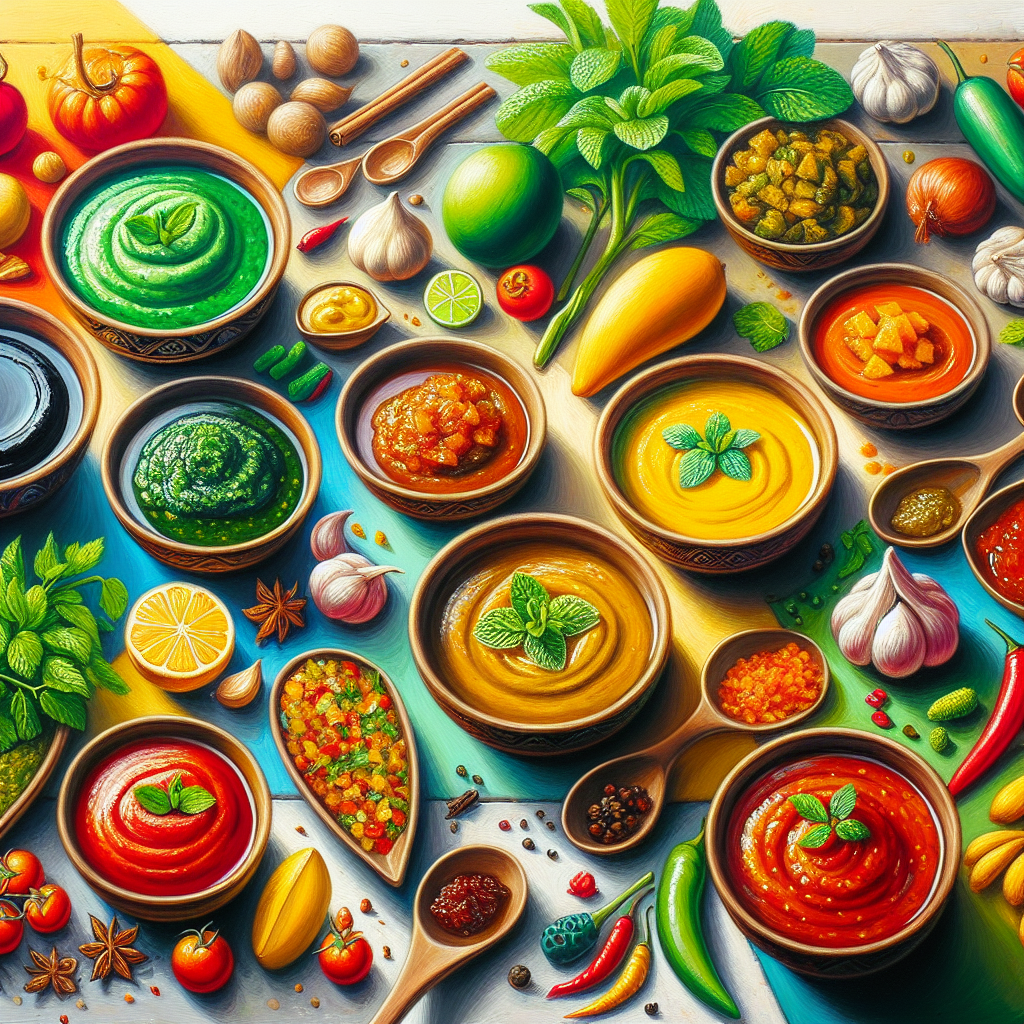Discover the wonderful world of Indian chutneys and pickles and experience the sheer joy of creating these flavorful condiments. On IndianCulture.com, you can learn all about the diverse cuisine of India and explore the vibrant spices and regional specialties that define this rich culture. Whether you’re a seasoned chef or a novice in the kitchen, making Indian chutneys and pickles is a delightful culinary adventure that allows you to infuse your dishes with unique and tantalizing flavors. So grab your mortar and pestle, gather your ingredients, and get ready to embark on a journey of taste and tradition.

Types of Indian Chutneys
Mint Chutney
Mint chutney is a popular condiment in Indian cuisine. Made with fresh mint leaves, this chutney is bright green in color and has a refreshing and tangy flavor. It is commonly served as a dipping sauce for snacks like samosas and pakoras, or as a spread for sandwiches and wraps. Mint chutney can also be used as a marinade for grilled meats or added to yogurt for a flavorful dip.
Coconut Chutney
Coconut chutney is a staple in South Indian cuisine. It is made with freshly grated coconut, green chilies, and tempered with mustard seeds, curry leaves, and asafoetida. This chutney has a creamy texture and pairs well with dosas, idlis, and vadas. It can also be used as a base for curries or added to rice for a delicious coconut flavor.
Tamarind Chutney
Tamarind chutney, also known as imli chutney, is a sweet and tangy condiment. It is made by simmering tamarind pulp with jaggery (unrefined cane sugar) and a blend of spices like cumin, ginger, and black salt. Tamarind chutney is commonly used in chaat dishes, such as bhel puri and pani puri, to add a burst of flavor. It can also be enjoyed with samosas or drizzled over grilled meats.
Coriander Chutney
Coriander chutney, also called cilantro chutney, is a versatile condiment that can be found in many Indian households. It is made with fresh coriander leaves, green chilies, garlic, and lemon juice. This chutney has a vibrant green color and a zesty flavor. It can be used as a spread for sandwiches, a topping for chaat dishes, or a dip for snacks like pakoras and kebabs.
Key Ingredients for Indian Chutneys
Fresh Herbs
Fresh herbs play a vital role in Indian chutneys, as they add a burst of flavor and aroma. Mint, coriander, and curry leaves are commonly used in various chutney recipes. These herbs are packed with essential nutrients and can contribute to the overall health benefits of the chutneys.
Spices
Spices are the backbone of Indian cuisine, and they bring depth and complexity to chutneys. Commonly used spices in chutneys include cumin, mustard seeds, turmeric, and red chili powder. These spices not only enhance the flavor but also provide potential health benefits, such as anti-inflammatory properties and improved digestion.
Citrus Fruits
Citrus fruits like lemon and lime are often used in Indian chutneys to add a tangy and refreshing element. The juice and zest of these fruits can balance the flavors and brighten up the chutneys. Citrus fruits are also a good source of vitamin C and antioxidants, which can boost the immune system.
Nuts and Seeds
Nuts and seeds are frequently used in Indian chutneys to add texture and richness. Common choices include peanuts, sesame seeds, and cashews. These ingredients provide a nutty flavor and can also contribute to the nutritional value of the chutneys, as they are a good source of healthy fats, protein, and minerals.

Process of Making Indian Chutneys
Gathering Ingredients
To make Indian chutneys, the first step is to gather all the required ingredients. This includes fresh herbs, spices, citrus fruits, nuts, and seeds. Make sure to select fresh and high-quality ingredients to ensure the best taste and flavor.
Blending or Grinding
Once the ingredients are gathered, they are typically blended or ground together to form a paste or sauce-like consistency. This can be done using a blender, food processor, or traditional mortar and pestle. Blending or grinding helps to extract the flavors and combine all the ingredients into a homogeneous mixture.
Seasoning and Tempering
After blending or grinding, the chutney is seasoned and tempered to enhance the flavors. Common seasoning ingredients include salt, sugar, and lemon juice. Tempering involves heating oil or ghee and adding mustard seeds, cumin seeds, and other spices to release their flavors.
Storing
Indian chutneys can be stored in an airtight container in the refrigerator. This helps to preserve the freshness and flavors of the chutneys for a longer period. Proper storage is essential to prevent spoilage and maintain the taste and quality of the chutneys.
Flavorful Indian Pickles
Mango Pickle
Mango pickle, also known as achar, is a popular Indian pickle that is enjoyed all year round. It is made by marinating raw mangoes in a blend of spices, oil, and vinegar. Mango pickle has a tangy and spicy flavor, and it can range from mild to hot, depending on the choice of spices used.
Lemon Pickle
Lemon pickle is another tangy and spicy pickle that is commonly made in Indian households. It is made by marinating lemon pieces in a mixture of spices, salt, and oil. Lemon pickle has a strong and vibrant flavor that pairs well with various Indian dishes.
Mixed Vegetable Pickle
Mixed vegetable pickle is a medley of vegetables like carrots, cauliflower, and green beans that are pickled in a spicy and tangy brine. This pickle adds a burst of flavors and colors to the dining table. It can be enjoyed with rice, roti, or as a side dish with any meal.
Chilli Pickle
Chilli pickle is for those who love spicy and fiery flavors. Made by marinating whole or chopped green chillies in a blend of spices and oil, this pickle packs a punch. It is a popular accompaniment to Indian meals, especially when you want to add some heat to your dish.

Ingredients for Indian Pickles
Raw Mangoes
Raw mangoes are the star ingredient in mango pickle. They have a tangy and slightly sour flavor that mellows as they are pickled. Raw mangoes are rich in vitamin C and antioxidants, which can boost the immune system and promote good health.
Lemons
Lemons are used to make tangy and zesty lemon pickle. They add a refreshing and citrusy flavor to the pickle. Lemons are also a good source of vitamin C and can aid digestion.
Mixed Vegetables
A variety of vegetables like carrots, cauliflower, and green beans can be used to make mixed vegetable pickle. These vegetables add different textures and flavors to the pickle, making it a delightful combination. They are also rich in vitamins and minerals, providing essential nutrients to the body.
Green Chillies
Green chillies are a staple in Indian cuisine and are used to make spicy chilli pickle. They provide a pungent and fiery flavor to the pickle. Green chillies are known to boost metabolism and have antibacterial properties.
Traditional Methods of Making Pickles
Sun-drying
Sun-drying is a traditional method of making pickles that involves drying the ingredients under the sun. This helps to remove moisture and preserve the pickles for a longer duration. Sun-drying also adds a unique flavor and texture to the pickles.
Marination
Marination is a crucial step in the pickle-making process. It involves allowing the ingredients to absorb the spices and flavors over a certain period. This helps to enhance the taste and develop the pickle’s distinct flavors.
Aging
Aging is an important aspect of pickle making, as it allows the flavors to mature and develop over time. Pickles are typically stored in airtight containers in a cool and dark place for several weeks or months. This process enhances the taste and texture of the pickles.
Fermentation
Fermentation is a traditional method used to make certain types of pickles, such as mango pickle. It involves naturally fermenting the ingredients in a brine solution. This process enhances the flavors and creates probiotics, which are beneficial for gut health.
Health Benefits of Indian Chutneys and Pickles
Digestive Aid
Many Indian chutneys and pickles contain ingredients like mint, ginger, and spices that aid digestion. These ingredients can help stimulate the digestive juices and promote better digestion of food. Chutneys and pickles can be consumed in moderation to support a healthy digestive system.
Source of Essential Nutrients
Indian chutneys and pickles are often made with fresh herbs, fruits, and vegetables that are rich in essential nutrients. They can provide vitamins, minerals, and antioxidants that are beneficial for overall health and well-being. Including chutneys and pickles in your diet can contribute to a balanced and nutritious meal.
Preservation of Food
Chutneys and pickles have been an integral part of Indian cuisine for centuries due to their ability to preserve food. The use of spices like turmeric, mustard seeds, and vinegar helps to inhibit the growth of bacteria and prolong the shelf life of the chutneys and pickles.
Boosting Immunity
Some ingredients used in Indian chutneys and pickles, such as citrus fruits, ginger, and spices, are known for their immune-boosting properties. They are rich in vitamins, antioxidants, and anti-inflammatory compounds that can strengthen the immune system and protect against illnesses.
Pairing Chutneys and Pickles with Indian Dishes
Dosas and Idlis
Mint chutney and coconut chutney are popular accompaniments to dosas and idlis. The refreshing and tangy mint chutney complements the savory flavors of dosas and idlis, while coconut chutney adds a creamy and subtle sweetness.
Samosas and Pakoras
Tamarind chutney and mint chutney are commonly served with samosas and pakoras. The sweet and tangy tamarind chutney adds a delicious contrast to the savory and crispy samosas and pakoras. Mint chutney provides a fresh and zesty flavor that elevates the taste of these fried snacks.
Curries and Rice
Chutneys and pickles can be paired with curries and rice to add a burst of flavor. Coriander chutney and mango pickle are excellent choices to enhance the taste of curries. Lemon pickle can be enjoyed with rice dishes, providing a tangy and zesty element.
Breads and Parathas
Indian breads like roti, naan, and parathas are often served with a side of chutney or pickle. Mint chutney complements the soft and fluffy texture of breads, while mango pickle adds a burst of tanginess. Coconut chutney pairs well with South Indian breads like dosas and uttapams.
Tips and Tricks for Making Chutneys and Pickles
Balance Flavors
When making chutneys and pickles, it is crucial to balance the flavors of sweet, sour, salty, and spicy. Taste the chutneys and pickles as you go and adjust the ingredients accordingly. Adding a little bit of sweetness or acidity can help balance the flavors and create a harmonious taste.
Experiment with Ingredients
Indian chutneys and pickles offer a great opportunity for culinary experimentation. Feel free to experiment with different herbs, spices, and ingredients to create unique and personalized flavors. Try adding a twist to traditional recipes by incorporating your favorite ingredients or spices.
Proper Storage
To ensure the longevity of chutneys and pickles, it is essential to store them properly. Use clean and airtight containers to store the chutneys and pickles in the refrigerator. This will help preserve their flavors and prevent spoilage. Make sure to label the containers with the date of preparation.
Maintaining Hygiene
Hygiene is crucial when making chutneys and pickles, as it involves handling fresh ingredients and preserving them for an extended period. Wash your hands thoroughly before starting the preparation. Clean and sanitize all the equipment and utensils used. Pay attention to proper storage to avoid contamination.
Exploring Regional Variations
South Indian Chutneys
South India is known for its wide variety of chutneys. Some popular ones include tomato chutney, onion chutney, and peanut chutney. These chutneys often have a spicy and tangy flavor, making them a perfect accompaniment to dosas, idlis, and vadas.
North Indian Pickles
North Indian pickles are characterized by their bold and robust flavors. Some notable varieties include mango pickle, lemon pickle, and carrot pickle. These pickles are often spicy and tangy, adding a punch of flavor to North Indian meals like roti, paratha, and pulao.
East Indian Chutneys
The eastern region of India offers a unique array of chutneys. Mustard-based chutneys, such as kasundi and posto, are popular in West Bengal. These chutneys have a strong and pungent flavor. Tamarind chutney and mint chutney are also commonly enjoyed in this region.
West Indian Pickles
The western region of India is famous for its pickles, particularly the spicy and tangy chilli pickle. Other popular pickles from this region include mango pickle, lime pickle, and mixed vegetable pickle. These pickles add a burst of flavors to Gujarati and Rajasthani meals.
